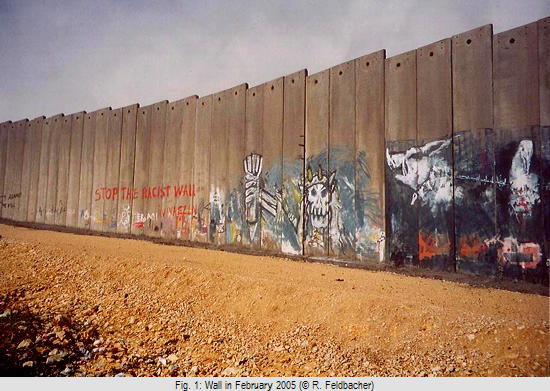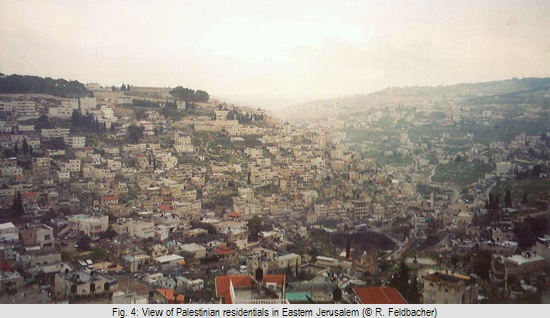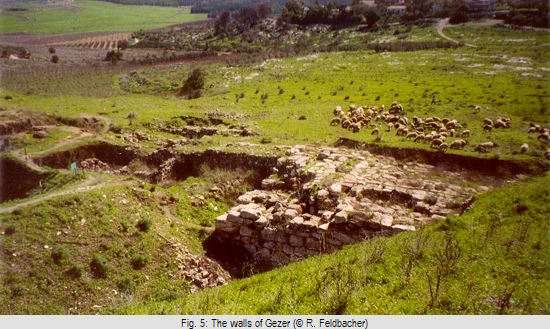The Old Testament describes many conflicts in the Holy Land and the heroic deeds of a brave small people fighting for their independence from the empires of Mesopotamia, Egypt and later on from those of the Mediterranean. In all conflicts Palestine was an important land bridge to be fought for. Threats and challenges led the people of the Old Testament to a firm belief. On one hand presumably true social, economic and geographic circumstances were reflected in the stories of the Holy Book, on the other hand those stories were influenced by religious and political propaganda - which has always been an important medium in history of mankind. Moreover misinterpretations happened because of brevity. For a long period of time the people in that region were engaged in their proper society and reacted on the aggressive expansion of the foreign powers with national-religious isolation.
Difficulties in finding evidence on the topic of "ancient warfare" begin with historic topography, and can partially be solved by using interdisciplinary procedures, such as geography, archaeology [2], surveys, history, and linguistics. Battles in open fields in particular are intangible, due to the lack of remains even from historic times, in which more must have occurred than assumed. Destruction levels in inhabited areas are easier to trace. Due to the archaeological context significant data can be provided for proper interpretation. In addition literal and iconographic sources exterior of the bible are important. Moreover observations of demographic factors influencing the environment are significant. Letters from Amarna [3] prove that longer periods of stability and peace led to increasing population, complicating supply and then again leading to hunger, war and epidemics.
Destroyed settlements, the upcoming of new house models and burials, new religious ideas, the change of daily life items and weapons, and the renaming of places and people prove changes of society, and are often influenced by violent impulses. It is complicated to use non-substantial findings as evidence (the so-called "argument from silence"). [4]
It is difficult to keep the wide-ranging subject of ancient warfare manageable within the boundaries of this article. Furthermore another obstacle is outlining the boundaries of the region. [5] Particularly during antiquity, borders were set rudimentarily [6], and also in the present only partially outlined (discussions about the autonomy of the Westbank, Gaza and the eastern part of Jerusalem, the dispute over the Golan Heights).
It is not only the difficulty of definition: The question for historic reliability of the Bible sparks off interest, emotion and often heavy disputes, more for religious and political reasons than historic ones as mentioned above. Professional discussions often degenerate to personal attacks. [7] This rather small area (meaning Israel as country and archaeology as topic) is still an ideological and political battleground. Moreover the continuous conflicts complicate excavations and researches.

Despite the fact that ancient tragedies turn out to be a lucky chance for archaeologists, destructions also happen nowadays due to cultivation by agriculture and building projects. Besides the loss of cultural heritage human dramas should not be ignored. The construction of the wall (fig. 1) and arbitrary destruction of residential houses (fig. 2 and fig. 3) especially in the occupied Territories lead to suppression of the Palestinian population. The need of Christian believers (as in case of Bethlehem) to visit the Church of the Nativity is also restrained.
Unfortunately archaeology itself is also politically targeted: Israeli archaeology developed quickly after the establishment of the state in 1948. The 1967 and 1973 wars opened previously inaccessible areas in the Sinai, the West Bank, and the Golan Heights to Israeli archaeologists. In the same period, important discoveries were made in the Jewish Quarter, on the Temple Mount, and in the "City of David" areas in Jerusalem.
By (ab)using archaeology "facts" are created for redefining Jerusalem from the city of three world religions to the eternal undivided capital of the Jewish state. [14] "Does peace in the Near East begin with the archaeologists?", the newspaper "Haaretz" asked two years ago. [15] A conference of Israeli and Palestinian archaeologists in the Van Leer-Institute in Jerusalem had been the occasion. The experts debated a treaty regarding the division of archaeological sites and cultural heritage in the Holy land, which would come to an effect, in case a peace treaty and the foundation of a Palestinian state would take place. Both sides agreed to treat the historic sites in a purely scientific manner. Unfortunately all approaches to peaceful cooperation are set back repeatedly, due to conflicts and land reclamation.
Next to general human tragedy having negative influence on tourism and therefore on economics, military conflicts are the main problem. Countries, already weakened by the crisis, lose another source of income. The current conflicts also have long-term consequences. Rebuilding infrastructure has priority rather than restoring relics of the past. Often the relics become destroyed or sold to antique dealers, which prevents coming to archaeological conclusions. Archaeology can only be treated adequately in a peaceful environment. Above all it should be emphasized at last that the intention of the Holy Book was to reveal forms of violence and to show a way to overcome them. As always, the Bible can be interpreted differently, either by living the citation "Death rather than dishonour" (reminding on Lev 26:36-37, Deut 20:5-9 and Dan 3) [16], or by not only declaring resolutions concerning the conflict in the Holy Land and the whole Near Eastern Region, but by hopefully choosing the more constructive path to a peaceful solution, as already the Psalms 46, 10 say:
Literature

Theoretically, two bases of law concerning rescue excavations exist: the law of antiquities and the law for regulation of work by the Israel Department of Antiquities. The latter has to give permission for construction. After an archaeologist has inspected the location, he decides further procedure. [8] If the survey reveals antique remains, construction plans are changed. If this is not possible, a rescue excavation is decreed, and half of the costs have to be funded by the "causer" who can obtain an estimate by several institutions, leading to a competition with the disadvantage of choosing the cheapest and often less qualified offer. Staff shortage leads to inadequately published results.
As archaeology conducts destruction by itself, each uncovered location is lost. Nonetheless the improvement of infrastructure is important for a country with high demographic growth. Therefore a documentation of the remains is necessary. [9]
The problem of claiming cultural heritage goes deeper. Several sides have to be considered: At the end of February 2010 as response to the intention of Israel to incorporate two important sites in the Westbank [10] into a program of restoration, the general secretary of the UNESCO (Irina Bokowa) demurred, fearing tensions as consequence of those plans. That announcement by the government led to protest by the Palestinian people who interpreted that action as annexation of land and religious sites. [11] Especially those tombs named above are a microcosm in the Near Eastern conflict, being important for the Jewish and the Muslim communities. [12] Due to a Resolution by the UN after an incident in 1994 the Temporary International Presence in Hebron (TIPH) should have guaranteed security for the population, economic development and a secure environment for international aid projects.
After discussing these rather current examples of many conflicts the focus moves on to the Holy City: As often emphasized, some archaeologists tried to prove the existence of a Davidic kingdom for decades, also or respectively in particular for stating the historic right for the Holy city (fig. 4). [13] On the other hand the Palestinians see themselves and their history pushed away and ignored.

The author has been involved in a remarkable example at Tell el-Ajjul, a rich MB/LB site in the Gaza strip: Due to the second Intifada excavations could not be continued after October 2000. Since that time damages are done by planting and looting in a tremendous huge area, leading to the removal of ancient structures or even parts of the entire tell. But in particular the people in the Gaza Strip, being without economic perspectives, try to survive by cultivating, but also by selling the findings exposed by caterpillars as well as targeted looting. Preservation of culture has no priority under such circumstances.
Besides loss of cultural heritage under conditions as those mentioned above, another obstacle comes up: Many excavations had been cancelled repeatedly for similar reasons (as Hazor, Megiddo and Kinneret), preventing in consequence archaeological research in the Near East. Every student of archaeology and related subjects hopes for a secure workplace. The discussed conflicts sometimes lead to closedowns of excavations, and therefore to changes of the major field of study. In the longer term special domains lose significance or are given up altogether. Education in that discipline cannot be continued, when the senior staff leaves the projects with all their knowledge, leading in consequence to a gap between generations. Keeping excavated sites open leads to destruction. Many sites are exposed to weather and flock (fig. 5).

"Breaking bow, shattering the spear, burning the shield, melting the sword!"
Avigad, N., Discovering Jerusalem. Nashville 1983.
Dever, W.G. - Thompson, T.L. - Ahlström, G.W. - Davies, Ph.R., Will the Real Israel Please Stand Up?" Archaeology and Israelite Historiography Part I. BASOR 297 (1995): 61-80.
Finkelstein, I. - Silberman, N.A., The Bible Unearthed. Archaeology's New Vision of Ancient Israel and the Origin of its Sacred Texts. London 2001.
Gabriel, R.A., The Military History of Ancient Israel. Westport (Conn.) 2003.
Kitchen, K.A., On the Reliability of the Old Testament, Cambridge 2003.
Lohfink, N., Krieg und Staat im Alten Israel. Barsbuettel 1992.
Mazar, B., The Archaeological Excavations near the Temple Mount, in: Jerusalem Revealed. Archaeology in the Holy City 1968-1974, Jerusalem 1975.
Oren, A., The Territorial Dimension of Israel's National Security: A Neglected Topic, Israel Studies 12(1), Special Issue: "An Army That Has a State?" eds. G. Sheffer and O. Barak (2007): 149-170.
Oren, A., Drafted Territories - The Creation of Israeli Army Hegemony over the State's Land and its Expanses During its Early Years, 1948-1956, Givatayim 2009 (Hebrew).
Oren, A. (ed.), Space and Security - New Approach to the Use of Land Resources for Security and Military Needs , Bul. 11, Jerusalem 2009 (Hebrew).
James, B.P. (ed.), Ancient Near Eastern Texts Relating to the Old Testament. Princeton 1969 (3rd ed.).
Rainey, A.F., The Sacred Bridge - Carta's Atlas of the Biblical World. Jerusalem 2006.
Redford, D.B., The Wars in Syria and Palestine of Thutmose III. Boston 2003.
Rogerson, J.W. - Davies, Ph.R., The Old Testament World. Edinburgh 2005.
Shifer, Z. - Oren, A., On Land and National Security: Economic Aspects of the Control of Resourses by the Defense Sector in Israel, The Economic Quarterly 55.03 (2008): 387-409 (Hebrew).
Zerubavel, Y., Bar Kokhba's Image in Modern Israeli Culture. In: Peter Schaefer (ed.): Bar Kokhba War Reconsidered: New Perspectives on the Second Jewish Revolt Against Rome (Texts and Studies in Ancient Judaism, 100). Tuebingen 2003, 279-297.
[1] Palestine Royal Commission/Peel Commission (Text of Official Summary of its Report) 1937, 2. It was one of many commissions before the founding of the state Israel that tried to solve the Arab-Jewish conflict. See also the Haycraft Commission of Inquiry (1921), the Commission on the Palestine Disturbances of 1929 (The Shaw Commission), the Palestine Partition Commission (The Woodhead Commission, 1938), the Anglo-American Committee of Enquiry Regarding the Problems of European Jewry and Palestine (1946), the United Nations Special Committee on Palestine (UNSCOP, 1947).
[2] For a long time only the coastal area and the plains have been researched, but the hilly regions of Israel between the plain of Jesreel and Bersheba have been ignored. Those villages have not been fortified, leading to the conclusion that they have not been exposed to attacks from outside. Finkelstein - Silberman 2002, 121ff.
[3] Rainey 2006, 199: Letter by Biridija of Megiddo to the pharao, Vs. 30ff. "The city [Megiddo] is burnt up by epidemics, by a plague, …" (EA 244).
[4] Gabriel 2003, 70ff.
[5] Rogerson - Davies 2005, 21ff.
[6] W.G. Dever formulated that today scholars recognized that "ancient Israel" cannot be comprehended simply in terms of its own self-understanding. It must be situated in its broader Palestinian and ancient Near Eastern context, including its long-term settlement history. Dever 1995, 61.
[7] Israel Finkelstein once said, "the battle for the Bible is becoming more fierce"; Finkelstein - Silberman 2001, 4.
[8] For the compliance with those laws superintendents of the Department of Antiquities are responsible. Annotation by the author.
[9] Whereas in former years archaeological work has been focussed on tell-excavations, due to many construction projects many small and partially unknown sites are examined nowadays. Cooperation between several institutions could be a solution: As in Jaffa under the title "Jaffa Cultural Heritage Project", the control is in hands of the Israel Dept. of Antiquities and the Univ. of Los Angeles (UCLA), the Univ. of Mainz, Getty Museum and independent scientists, who are responsible for the reworking of the cultural heritage. Interview with M. Peilstöcker, in Antike Welt 1/2008, 29-31.
[10] The patriarch´s tomb in Hebron and the tomb of Rachel in Bethlehem. Annotation by the author.
[11] Ismail Haniyeh (Prime Minister of the Palestinian National Authority) even claimed a new Intifada. Annotation by the author.
[12] Israel emphasizes that this action only would serve preservation of those sites and not changing the status quo. These locations are for the moment still administrated by the Waqf, as is the plateau of the temple mount, another bone of contention. (Waqf is the Muslim administration of the religious foundations and religious trust charged with oversight of the locations. Annotation by the author.)
[13] Those archaeologists see themselves as soldiers in service of a national fight. The excavations in the "City of David" (called in propagandic terms) have been handed over to Ateret Cohanim, an ultra-nationalistic religious society, building in the provocative parts of the town. Also Israeli archaeologists protest against the way of research - only subject is to find proofs supporting the claim for the temple mount. The newspaper Haaretz apparently even wrote about the risk of collapsing houses due to that work. Uri Avnery, 10.10.2009.
[14] The Hasmonean tunnel at the Western wall i.a. has been opened in 1996 for tourism against the resistance of the Muslim population. Another reason for new conflicts could also be the extended excavations by the "Elad" foundation of Davi Be'eri in the Eastern part of Jerusalem. The United States and the European Union convict on that charge. Ugo Rankl - Yonathan Weitzmann - Jeremy Portnoï, Nissim Massas and Ada Etgar, excerpt from ARTE GEIE / Blue Press - France 2009.
[15] Information from: WeltOnline, 11. April 2008. In 2007 in Jerusalem, Hebrew University's Dr. Eilat Mazar, along with representatives from the Committee Against the Destruction of Antiquities, was in the Israeli High Court of Justice attempting to halt the work on the Temple Mount being conducted by the Muslim Waqf. It was a reaction to the approval by the Israeli authorities in February 2007 for a project rebuilding a ramp, damaged by a storm, to the Mugrabi-door, the entrance to the temple mount and the Al Aksa-Moschee-platform. Richard L. Cravatts, Israel: Archaeology and the Propaganda War of Lies, 10/16/2007.
[16] That citation has been used for soldiers of the Israel Defense Force inaugurating them in Masada after having completed their Tironut (IDF basic training). Nonetheless military, religious and ethic basic values exist as IDF's official doctrine as Tohar ha-Neschek ("Purity of the Weapon") and Pikuach nefesch ("Rescuing Life").
![]() © Rainer Feldbacher
© Rainer Feldbacher
e-mail: rainer.feldbacher@univie.ac.at
This article should be cited like this: R. Feldbacher, Traces of Destruction: Ancient Warfare, Archaeology and Modern Land Reclamation in the Holy Land, Forum Archaeologiae 56/IX/2010 (http://farch.net).